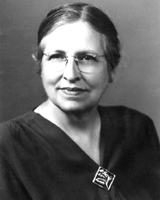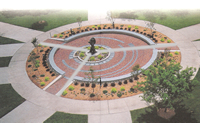
Anna Jane Michener
is honored with a Brick from Annabelle Haupt, John H. Michener, W. Ralph Michener, Joanne Ross, and May Louise Stewart.

Anna Jane Michener
The Gentle, Unquenchable Firebrand
1892-1965
"The John and Anna Michener Elementary School" - The naming of this school in 1973 was unprecedented in many ways. With respect to Anna Jane, she was the first Wichita woman so honored by the Board of Education. This tribute to Anna Jane recognized her commitment to the Wichita community, especially her concern for its youth, as well as her conviction that education, formal and informal, was the key to social progress.
Anna Jane was born in Harper County, Kansas. Her parents, Harry D. and Louie K. Baker, moved the family to Wichita in 1912 so their daughters could attend Friends University. There she got her AB and won a fellowship to the University of Kansas where she earned her MA in English. She taught three years in Kansas, including Wichita High (Wichita's only public high school at the time), but quit teaching when her husband, John Michener, returned from World War I and they started a family.
In the summer of 1924, between their first two children and their last two, she was part of a delegation of young United States Quakers selected to attend a youth conference in London and visit Friends (Quakers) on the continent. This eight-week exposure to broader Quaker thought, plus her husband's wartime experiences profoundly influenced the values and philosophy on which she grounded all of her activities. Seeing people as capable of loving one another if existing barriers of misunderstandings and prejudice were overcome, rather than as the virtuous and the villainous, she raised her children to be sensitive to others' needs and respectful of their rights.
With John's support she provided their children with a stimulating environment based on love, democratic principles and guidance from experts in child psychology. One innovation she adopted was Family Council, where the children held formal offices and had a voice in such things as job assignments, family expenditures and vacation plans.
By 1933 she had moved from volunteer leader for a PTA child development study group at her children's grade school to the Wichita Public Schools' newly created Family Life Education staff, serendipitously starting on a career outside the home that spanned 32 years. She remained on the staff until her death, serving as acting head from 1944 to 1948, but always teaching at least part time.
When the Vocational Education Division of the US Office of Education selected Wichita in 1938 to be one of four experimental centers for Family Life Education, her work expanded to include assisting the development of the Southwest Wichita Community Center in the economically and socially prostrate Santa Fe area. The Center's purpose was self-help, education (through facing problems in business meetings, classes or discussion groups), recreation and social life. Over the years she worked with the Center in many roles - instigator, member, consultant, teacher, leader, and trustee - going far beyond the requirements of her professional connection. She helped the Center grow from a storefront meeting of a small group to an organization owning its own building with resident director-caretakers, a playground, an active program and a very essential credit union. She presided over the 1941 organization of the credit union, was its president for its 10 toughest years, and was a board member until her death. A staff member of the US Office of Education was sent to Wichita from Washington to interview her as to how she and the Center had accomplished so much, but shocked, attended her memorial service instead.
Concern for the city's youth also led her to a 30-year-plus membership in the YWCA, 13 years of which was on its board, two as president. It was there that she started her major work on race relations, initially by participating in a study of the Y's swimming pool policy. The study committee's recommendation (8 to 4) that the pool be opened was tabled by the board. Outraged, she responded with a lifetime dedication to finding ways to enlighten citizens about the pervasive presence and destructive impact of prejudice and discrimination.
She began by chairing the Y's Race Relations committee. Efforts to achieve community inter-racial programs followed, working with the wider YWCA, YMCA, and the Council of Churches, Catholics, Jews and community groups. These joint efforts culminated in 1947 in a Clinic on Race Relations sponsored by the Race Relations Committee and the Race Relations Section of the Federal Council of Churches. There were also workshops, forums, radio talks, panel discussions and articles.
The YW was a significant force in easing racial restrictions. Its cafeteria provided the first public downtown dining facility in Wichita having no racial restrictions. In 1956, during her retiring year as president of the YWCA, the Y finally ended its racial restrictions on the use of its pool. Efforts at the Y were the genesis, in 1956, for the organization of a broader community effort, the Interracial Community Committee on Social Action (CCSA). Anna Jane served as its chairman from the start until her death nine years later. The Committee was an interracial group whose members were representatives from other organizations such as the Urban League and the AAUW, persons asked to participate because of their leadership roles in the community, or deeply concerned individuals. Prefiguring in its operations the kind of community it wished to build, the CCSA sought through education and peaceful confrontation to overcome discrimination wherever possible. Restaurants that discriminated were visited by a pair of women - one Black, one White. If denied service they quietly made appointments with the manager and returned to present the case for integration. Cards thanking restaurants that served all races and urging others to do likewise were handed to restaurants by their customers. Thousands of these were distributed. Job discrimination was another area of concern. One approach included distributing stickers, to be placed on bills, reading "As your customer, I welcome being served by any qualified person regardless of race, creed, or color." There were many other projects. One of her friends told Anna Jane that probably "when she got to heaven she would walk up to God and say 'I've got an idea.'"
She had ever increasing involvement in local and state efforts to fight discrimination:
working on the Fair Housing Committee, chairing the United Church Women's Social Relations program for the state and acting as the assistant project director of Women in Community Service. She helped initiate the Human Relations Commission of Wichita and then served on it for six years. Other community activities included seven years of service on the Library Board, one as president, where she fostered development of the Friends of the Library Association.
Beginning long before her deep involvement in race relations she was active in other civic organizations, such as the League of Women Voters, where she served on both the local and state boards and as editor of the League's state magazine. She was a League leader in the lost fights for municipal ownership of the Water Company and for a public housing enabling act.
Concomitant with her civic activities she worked through Protestant, Catholic, and Jewish bodies and the local UN support group for peaceful solutions to national and international problems. She helped organize the first Wichita Council for Peace, joined the Women's International League for Peace and Freedom, served on the Central Committee of the Kansas Institute for International Relations, and was active on the Regional Executive Committee (Des Moines, IA) of the American Friends Service Committee, a recipient of the Nobel Peace Prize. In 1948, she was Wichita's representative in a Church Peace Mission to Washington, DC and the UN. Her conscientious opposition to war was not always welcomed, but her integrity was so respected that the very conservative Kansas Yearly Meeting, a Quaker body, appointed her chair of its Peace and Service Committee for 18 years, and she frequently served on the Ministry and Oversight Committee of University Friends Church, where she was an active member all her adult life.
By 1957, she was so well known and respected that three of the women's civic clubs asked her to run for the City Commission. Although she did not campaign for this honor or for the election she, to her great relief, fell a narrow 1,003 votes short of becoming one of the four nominees. In 1961 the Wichita Chapter of Hadassah named her as one of five Women of Valor. In1964 she was first runner up for Woman of the Year, recognition given by Theta Sigma Phi, a national honorary fraternity for women in journalism.
When people contemplated the wide scope, depth and duration of her activities and asked why she did not take more time for her personal life, her answer was that she could never forget that she had a responsibility for the world in which her children, indeed all children, were growing up.
The breadth and nature of her contributions were officially recognized at her death when the Wichita Board of City Commissioners paused in silence to honor and applaud "her outstanding and worthwhile service in working toward improvement of social and human relations for all citizens and fellow beings within our community." Its resolution enumerated her active memberships and service within University Friends Church, Family Life staff, Twentieth Century Club, Parent Teacher's Association, League of Women Voters, Wichita Council of United Church Women, American Association of University Women, YWCA, Library Board and Human Relations Commission.
Anna Jane approached issues and controversies with a low key, serene insistence that parties in disagreement were not antagonists but fellow seekers of the most appropriate way to move ahead. Passionately accepting the belief that, in Quaker terminology, there is that of the Divine in every person, she approached every one as an equal, accepting nothing less that that they all examine whether their actions were consonant with their values and the circumstances, while transmitting a conviction that each one of them had the inner strength to make those changes necessary to do that which they knew was right. Working with her was an inspiring and transforming experience. At her memorial service and in letters after her death, friends, students, and coworkers spoke primarily of how they had been inspired and their lives and values changed by her faith in people and their strengths, her sensitivity to injustice, and her concern that chosen responses should open minds and change hearts - not create warring camps - perhaps her greatest contribution. She encountered many disappointments. Her goals for herself were so high she often wrestled with a sense of failure, but she never lost her faith in the power of love and democratic principles, nor her lifetime dedication to making the world a better place for all.










